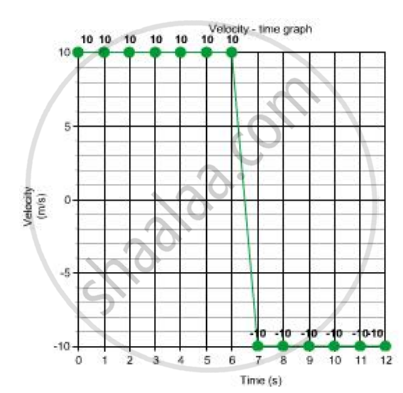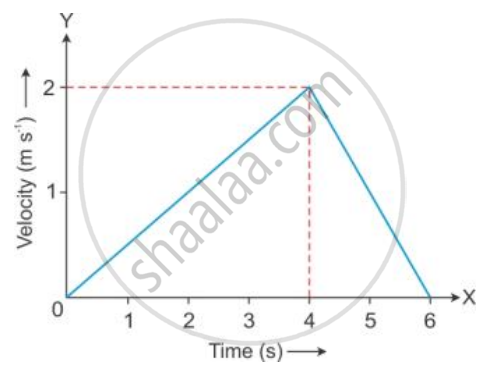Advertisements
Advertisements
प्रश्न
A ball moves on a smooth floor in a straight line with uniform velocity 10 m s-1 for 6 s. At t = 6 s, the ball hits a wall and comes back along the same line to the starting point with the same speed. Draw the velocity-time graph and use it to find the total distance travelled by the ball and its displacement.
उत्तर

Distance travelled in first 6 s = velocity × time
= 10 m/s × 6
= 60 m
Distance travelled in next 6 s = velocity × time
= 10 m/s × 6
= 60 m
Total distance travelled in 12 s = (60 + 60) m = 120 m
Total displacement = 0, as the ball returns its starting point.
APPEARS IN
संबंधित प्रश्न
What can you say about the nature of motion of a body if its displacement-time graph is A curve.
Figure shows the velocity-time graph of a particle moving in a straight line.

(i) State the nature of motion of particle.
(ii) Find the displacement of particle at t = 6 s.
(iii) Does the particle change its direction of motion?
(iv) Compare the distance travelled by the particle from 0 to 4 s and from 4 s to 6 s.
(v) Find the acceleration from 0 to 4 s and retardation from 4 s to 6 s.
A body is moving along a circular path of radius r. What will be the distance and displacement of the body when it completes:
Full revolution
A car travels at a uniform speed of 42 km/h. In 10 minutes, how much distance would it cover?
Is distance covered during nth second more than the distance covered in n seconds?
A particle moves along a circular path. How many times does it change its direction in two complete rounds?
A 50 m long train passes over a bridge at a speed of 30 km/h. If it takes 36 seconds to cross the bridge, calculate the length of the bridge.
The table below shows the distance travelled by two vehicles A and B during each second:
| Time (s) | 0 | 1 | 2 | 3 | 4 | 5 | 6 | 7 |
| Distance travelled by A (m) | 0 | 20 | 80 | 180 | 240 | 300 | 360 | 420 |
| Distance travelled by B (m) | 0 | 10 | 40 | 90 | 160 | 250 | 360 | 490 |
Which vehicle is moving with a constant acceleration?
______ is the length of the actual path covered by a body.
A quantity that has both magnitude and direction is ______.
